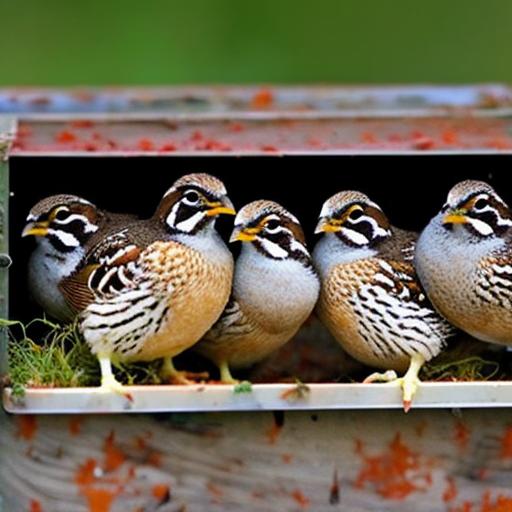A brooder box is an essential tool for raising quail chicks. It provides a warm, safe, and controlled environment for the chicks to grow and develop during their early stages of life. The brooder box mimics the warmth and protection that the mother quail would provide in the wild, ensuring that the chicks have the best possible start in life. The box is typically equipped with a heat source, such as a heat lamp or heating pad, to maintain the ideal temperature for the chicks. Additionally, the brooder box keeps the chicks contained, preventing them from wandering off and getting lost or injured. It also protects them from potential predators, ensuring their safety and well-being.
Furthermore, the brooder box provides a clean and hygienic environment for the quail chicks. It is essential to keep the chicks in a clean space to prevent the spread of diseases and parasites. The box can be lined with clean bedding, such as pine shavings or paper towels, which can be easily replaced when soiled. This helps to maintain the chicks’ health and minimize the risk of illness. Additionally, the brooder box allows for easy access to food and water, ensuring that the chicks have constant access to essential nutrients for their growth and development. Overall, the brooder box plays a crucial role in providing a nurturing and secure environment for quail chicks to thrive during their early stages of life.
Key Takeaways
- A brooder box is essential for providing warmth, safety, and proper care for quail chicks in their early stages of life.
- Quail chicks should be kept in a brooder box from hatching until they are 4-6 weeks old to ensure their health and development.
- Signs that quail chicks are ready to leave the brooder box include fully feathered bodies, ability to regulate body temperature, and active behavior.
- Potential risks of keeping quail chicks in a brooder box for too long include overcrowding, stress, and development of aggressive behavior.
- Transitioning quail chicks from the brooder box to the outdoors should be done gradually to acclimate them to the new environment and prevent shock.
- Monitoring quail chicks in the brooder box involves regular checks for temperature, food and water availability, and signs of illness or distress.
- Finding the right balance for quail chicks in the brooder box is crucial for their well-being and successful transition to adulthood.
Recommended Age for Keeping Quail Chicks in a Brooder Box
Quail chicks should typically be kept in a brooder box from the time they hatch until they are around 4-6 weeks old. During this time, the chicks are still developing their feathers and are not yet fully equipped to regulate their body temperature. Therefore, they rely on the warmth provided by the brooder box to stay healthy and comfortable. Keeping the chicks in the brooder box for this initial period allows them to grow and develop in a safe and controlled environment, ensuring that they have the best start in life.
It is important to monitor the chicks closely during this time to ensure that they are thriving and developing as they should. As they grow, their need for warmth decreases, and they will gradually become more independent. Once the chicks have developed their feathers and are able to regulate their body temperature effectively, they can be transitioned out of the brooder box and into a larger enclosure. This transition period is crucial for the chicks’ development and prepares them for life outside of the brooder box.
Signs that Quail Chicks are Ready to Leave the Brooder Box
There are several signs that indicate when quail chicks are ready to leave the brooder box and transition to a larger enclosure or outdoor space. One of the most obvious signs is when the chicks have developed their feathers and are able to regulate their body temperature effectively. This typically occurs around 4-6 weeks of age, depending on the breed of quail. Once the chicks are fully feathered, they are better equipped to handle fluctuations in temperature and can be transitioned out of the brooder box.
Another sign that quail chicks are ready to leave the brooder box is when they start exhibiting more active behavior and are constantly moving around. As they grow, they become more curious and adventurous, exploring their surroundings and showing increased independence. This is a natural progression as they become more self-sufficient and less reliant on the warmth and protection provided by the brooder box.
Additionally, if the chicks are consistently spreading out and spending less time huddling together for warmth, it may be a sign that they are ready to leave the brooder box. This behavior indicates that they are comfortable regulating their own body temperature and are ready for more space to move around and explore. Overall, it is important to observe the chicks closely and look for these signs to determine when they are ready to transition out of the brooder box.
Potential Risks of Keeping Quail Chicks in a Brooder Box for Too Long
While a brooder box is essential for providing a safe and nurturing environment for quail chicks, keeping them in the box for too long can pose certain risks to their development. One potential risk is that the chicks may become too reliant on the warmth provided by the brooder box, hindering their ability to regulate their own body temperature. This can lead to issues when they are eventually transitioned out of the box, as they may struggle to adapt to changes in temperature.
Another risk of keeping quail chicks in a brooder box for too long is that they may become overcrowded as they grow. As they develop, they require more space to move around and exercise. If they are kept in a small brooder box for an extended period, it can lead to stress and aggression among the chicks, as well as potential health issues due to lack of space.
Furthermore, prolonged confinement in a brooder box can limit the chicks’ exposure to natural elements and stimuli, which are essential for their development. They need to experience different temperatures, textures, and environments to build resilience and adaptability. Therefore, it is important to monitor the chicks closely and ensure that they are not kept in the brooder box for longer than necessary to avoid these potential risks.
Transitioning Quail Chicks from the Brooder Box to the Outdoors
Transitioning quail chicks from the brooder box to an outdoor enclosure is an important step in their development. It allows them to acclimate to natural elements and prepares them for life outside of the controlled environment of the brooder box. When transitioning quail chicks, it is essential to do so gradually to minimize stress and ensure a smooth adjustment.
One way to transition quail chicks from the brooder box to the outdoors is by introducing them to a larger enclosure first. This provides them with more space to move around and explore while still being protected from potential predators. Once they have adjusted to this larger space, they can then be gradually introduced to an outdoor area where they can experience natural elements such as sunlight, wind, and different textures underfoot.
It is important to monitor the chicks closely during this transition period and provide them with plenty of hiding spots and shelter to help them feel secure in their new environment. Additionally, it is crucial to ensure that the outdoor area is secure from predators and that the chicks have access to food and water at all times. By taking these steps, you can help quail chicks successfully transition from the brooder box to the outdoors, setting them up for a healthy and fulfilling life.
Tips for Monitoring Quail Chicks in the Brooder Box

Monitoring quail chicks in the brooder box is essential for ensuring their health and well-being during their early stages of life. There are several tips for effectively monitoring quail chicks in the brooder box:
1. Temperature: Keep a close eye on the temperature inside the brooder box using a thermometer. Ensure that it remains within the recommended range for quail chicks (around 95-100°F for newly hatched chicks) and adjust the heat source as needed.
2. Behavior: Observe the behavior of the quail chicks regularly. Look for signs of distress, such as excessive huddling or panting, which may indicate that they are too hot or too cold. Additionally, monitor their activity levels and ensure that they are moving around comfortably.
3. Food and Water: Check that the quail chicks have constant access to fresh food and water. Ensure that their feeders and waterers are clean and easily accessible to prevent any issues with feeding or hydration.
4. Cleanliness: Keep the brooder box clean by regularly removing soiled bedding and replacing it with fresh material. This helps to prevent disease and maintain a hygienic environment for the quail chicks.
5. Growth and Development: Monitor the growth and development of the quail chicks closely. Keep track of their weight gain, feather development, and overall health to ensure that they are thriving in the brooder box.
By following these tips, you can effectively monitor quail chicks in the brooder box and provide them with the care and attention they need during this critical stage of their development.
Finding the Right Balance for Quail Chicks in the Brooder Box
In conclusion, a brooder box plays a crucial role in providing a warm, safe, and controlled environment for quail chicks during their early stages of life. It allows them to grow and develop in a nurturing space while protecting them from potential risks such as predators and disease. However, it is important to find the right balance when keeping quail chicks in a brooder box. While it is essential for their initial development, keeping them in the box for too long can pose potential risks such as reliance on warmth, overcrowding, and limited exposure to natural elements.
It is crucial to monitor quail chicks closely in the brooder box and look for signs that indicate when they are ready to transition out of it. By providing them with a gradual transition to larger enclosures and outdoor spaces, you can help them acclimate to natural elements and prepare them for life outside of the brooder box. Additionally, effective monitoring of quail chicks in the brooder box ensures that they receive proper care and attention during this critical stage of their development. By finding this balance, you can help quail chicks thrive and grow into healthy adult birds ready for life in an outdoor environment.
If you’re wondering how long to keep quail chicks in a brooder box, you may also be interested in learning about the importance of providing a comfortable and secure nesting environment for your chickens. Check out this insightful article on chicken coop nest boxes to ensure that your feathered friends have the ideal space for laying and hatching eggs.
FAQs
What is a brooder box?
A brooder box is a heated enclosure used to raise young poultry, such as quail chicks, in a controlled environment.
How long should quail chicks be kept in a brooder box?
Quail chicks should be kept in a brooder box for approximately 4-6 weeks, or until they are fully feathered and able to regulate their own body temperature.
What temperature should the brooder box be kept at for quail chicks?
The brooder box should be initially kept at a temperature of around 95°F for the first week, and then gradually reduced by 5°F each week until the chicks are fully feathered.
What bedding should be used in the brooder box for quail chicks?
Bedding such as pine shavings or paper towels can be used in the brooder box for quail chicks. It is important to keep the bedding clean and dry to prevent any health issues.
What kind of feed should be provided to quail chicks in the brooder box?
Quail chicks should be provided with a high-quality game bird starter feed, which is specifically formulated to meet their nutritional needs for growth and development.
How often should the brooder box be cleaned while housing quail chicks?
The brooder box should be cleaned daily to remove any droppings and spilled feed, and the bedding should be replaced regularly to maintain a clean and healthy environment for the quail chicks.
Meet Walter, the feathered-friend fanatic of Florida! Nestled in the sunshine state, Walter struts through life with his feathered companions, clucking his way to happiness. With a coop that’s fancier than a five-star hotel, he’s the Don Juan of the chicken world. When he’s not teaching his hens to do the cha-cha, you’ll find him in a heated debate with his prized rooster, Sir Clucks-a-Lot. Walter’s poultry passion is no yolk; he’s the sunny-side-up guy you never knew you needed in your flock of friends!







